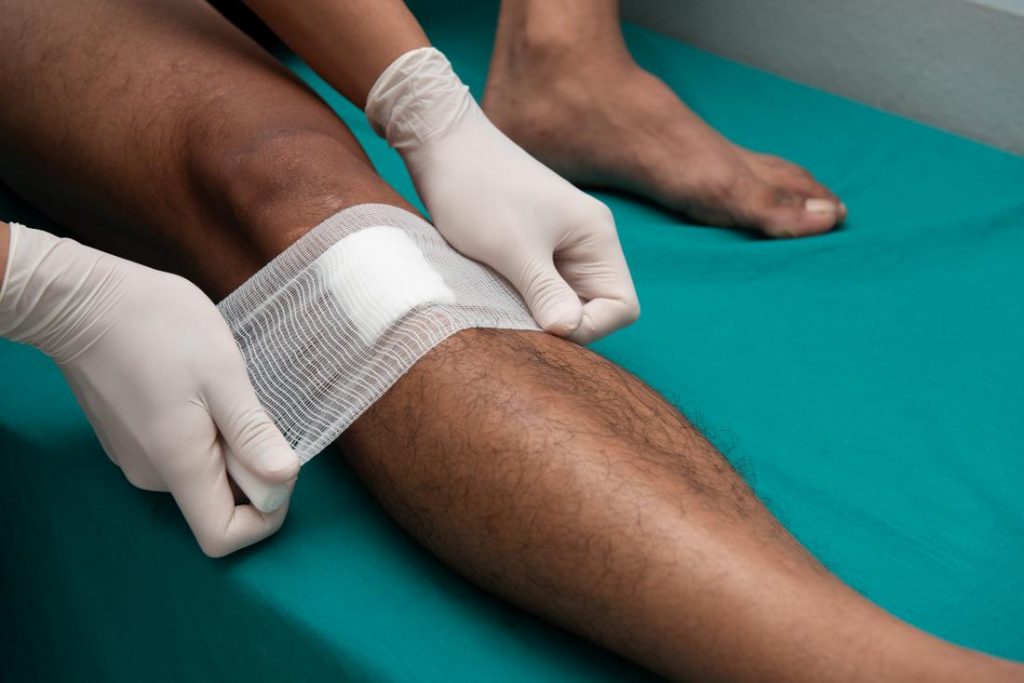Wound Care

Monitoring and controlling wound management is integral in the prevention of infection and further health complications. Our doctors and practice nurses offer care for chronic wounds in addition to wound care for all procedures done within the clinic. We also offer follow up wound care for post surgical procedures done in a hospital setting. A charge of $10.00 – $30.00 applies for the dressing materials used.
What is a chronic wound?
A skin wound that doesn’t heal, heals slowly or heals but tends to recur is known as a chronic wound. Some of the many causes of chronic (ongoing) skin wounds can include trauma, burns, skin cancers, infection or underlying medical conditions such as diabetes. Wounds that take a long time to heal need special care.
What are the causes of chronic wounds?
Some of the many causes of a chronic skin wound can include:
- Being immobile (pressure injuries or bed sores), where persistent localised pressure restricts blood flow
- Significant trauma injury to the skin
- Surgery – incisions (cuts made during operations) may become infected and slow to heal
- Deep burns
- Underlying medical conditions such as diabetes or some types of vascular disease
- Specific types of infection such as the Bairnsdale or Buruli ulcers (Mycobacterium ulcerans)
- Trophic ulcers, where a lack of sensation allows everyday trauma to lead to an ulcer – such as in diabetic neuropathy and leprosy.
What is the healing process for chronic wounds?
The healing process of a skin wound follows a predictable pattern. If something interrupts one or more healing stages, a wound may fail to heal. The normal wound healing stages include:
- Inflammatory stage – blood vessels at the site constrict (tighten) to prevent blood loss and platelets (special clotting cells) gather to build a clot. Once the clot is completed, blood vessels expand to allow maximum blood flow to the wound. This is why a healing wound at first feels warm and looks red. White blood cells flood the area to destroy microbes and other foreign bodies. Skin cells multiply and grow across the wound.
- Fibroblastic stage – collagen, the protein fibre that gives skin its strength, starts to grow within the wound. The growth of collagen encourages the edges of the wound to shrink together and close. Small blood vessels (capillaries) form at the site to service the new skin with blood.
- Maturation stage – the body constantly adds more collagen and refines the wounded area. This may take months or even years. This is why scars tend to fade with time and why we must take care of wounds for some time after they have healed.
What are the barriers to wound healing?
Factors that can slow the wound healing process include:
- Dead skin (necrosis) – dead skin and foreign materials interfere with the healing process.
- Infection – an open wound may develop a bacterial infection. The body fights the infection rather than healing the wound.
- Haemorrhage – persistent bleeding will keep the wound margins apart.
- Mechanical damage – for example, a person who is immobile is at risk of bedsores because of constant pressure and friction.
- Diet – poor food choices may deprive the body of the nutrients it needs to heal the wound, such as vitamin C, zinc and protein.
- Medical conditions – such as diabetes, anaemia and some vascular diseases that restrict blood flow to the area, or any disorder that hinders the immune system.
- Age – wounds tend to take longer to heal in elderly people.
- Medicines – certain drugs or treatments used in the management of some medical conditions may interfere with the body’s healing process.
- Smoking – cigarette smoking impairs healing and increases the risk of complications.
- Varicose veins – restricted blood flow and swelling can lead to skin break down and persistent ulceration.
- Dryness – wounds (such as leg ulcers) that are exposed to the air are less likely to heal. The various cells involved in healing, such as skin cells and immune cells, need a moist environment.
How is a chronic wound diagnosed?
Identify the cause of the chronic wound to control the underlying factors. For example, if a leg or foot ulcer is caused by diabetes, your doctor will review the control of your blood sugar levels and may recommend that you see a podiatrist to prevent recurring ulcers in future. In the case of an ulcer due to varicose veins, surgical treatment of the veins may be required. Diagnosis methods of a chronic wound may include:
- Physical examination including inspection of the wound and assessment of the local nerve and blood supply
- Medical history including information about chronic medical conditions, recent surgery and drugs that you routinely take or have recently taken
- Blood and urine tests
- Biopsy of the wound
- Culture of the wound to look for any (pathogenic) disease-causing micro-organisms.
How is a chronic wound treated?
The treatment recommended by your doctor depends on your age, health and the nature of your wound. General medical care may include:
- Cleaning to remove dirt and debris from a fresh wound. This is done very gently and often in the shower.
- Vaccinating for tetanus may be recommended in some cases of traumatic injury.
- Exploring a deep wound surgically may be necessary. Local anaesthetic will be given before the examination.
- Removing dead skin surgically. Local anaesthetic will be given.
- Closing large wounds with stitches or staples.
- Dressing the wound. The dressing chosen by your doctor depends on the type and severity of the wound. In most cases of chronic wounds, the doctor will recommend a moist dressing.
- Relieving pain with medications. Pain can cause the blood vessels to constrict, which slows healing. If your wound is causing discomfort, tell your doctor. The doctor may suggest that you take over-the-counter drugs such as paracetamol or may prescribe stronger pain-killing medication.
- Treating signs of infection including pain, pus and fever. The doctor will prescribe antibiotics and antimicrobial dressings if necessary. Take as directed.
- Reviewing your other medications. Some medications, such as anti-inflammatory drugs and steroids, interfere with the body’s healing process. Tell your doctor about all medications you take (including natural medicines) or have recently taken. The doctor may change the dose or prescribe other medicines until your wound has healed.
- Using aids such as support stockings. Use these aids as directed by your doctor.
- Treating other medical conditions, such as anaemia, that may prevent your wound healing.
- Prescribing specific antibiotics for wounds caused by Bairnsdale or Buruli ulcers. Skin grafts may also be needed.
- Recommending surgery or radiation treatment to remove rodent ulcers (a non-invasive skin cancer).
- Improving the blood supply with vascular surgery, if diabetes or other conditions related to poor blood supply prevent wound healing.
What self-care can be done at home to assist a chronic wound to heal?
Be guided by your doctor, but self-care suggestions for slow-healing wounds include:
- Do not take drugs that interfere with the body’s natural healing process if possible. For example, anti-inflammatory drugs (such as over-the-counter aspirin) will hamper the action of immune system cells. Ask your doctor for a list of medicines to avoid in the short term.
- Make sure to eat properly. Your body needs good food to fuel the healing process.
- Include foods rich in vitamin C in your diet. The body needs vitamin C to make collagen. Fresh fruits and vegetables eaten daily will also supply your body with other nutrients essential to wound healing such as vitamin A, copper and zinc. It may help to supplement your diet with extra vitamin C.
- Keep your wound dressed. Wounds heal faster if they are kept warm. Try to be quick when changing dressings. Exposing a wound to the open air can drop its temperature and may slow healing for a few hours.
- Don’t use antiseptic creams, washes or sprays on a chronic wound. These preparations are poisonous to the cells involved in wound repair.
- Have regular exercise because it increases blood flow, improves general health and speeds wound healing. Ask your doctor for suggestions on appropriate exercise.
- Manage any chronic medical conditions such as diabetes.
- Do not smoke.
When should I see my doctor?
Check your wound regularly. See your doctor immediately if you have any symptoms including:
- Bleeding
- Increasing pain
- Pus or discharge from the wound
- Fever.
Always see your doctor if you have any concerns about your wound.
[/cmsmasters_text][/cmsmasters_column][/cmsmasters_row]
